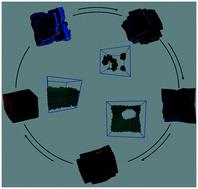当前位置:
X-MOL 学术
›
Mol. Syst. Des. Eng.
›
论文详情
Our official English website, www.x-mol.net, welcomes your
feedback! (Note: you will need to create a separate account there.)
A description of the formation and growth processes of CaTiO3 mesocrystals: a joint experimental and theoretical approach
Molecular Systems Design & Engineering ( IF 3.2 ) Pub Date : 2020-06-24 , DOI: 10.1039/d0me00043d Mario L. Moreira 1, 2, 3, 4, 5 , José Rafael Bordin 1, 2, 3, 4, 5 , Juan Andrés 6, 7, 8, 9 , José A. Varela 5, 10, 11, 12, 13 , Elson Longo 5, 14, 15, 16
Molecular Systems Design & Engineering ( IF 3.2 ) Pub Date : 2020-06-24 , DOI: 10.1039/d0me00043d Mario L. Moreira 1, 2, 3, 4, 5 , José Rafael Bordin 1, 2, 3, 4, 5 , Juan Andrés 6, 7, 8, 9 , José A. Varela 5, 10, 11, 12, 13 , Elson Longo 5, 14, 15, 16
Affiliation

|
In this paper, we report on a combined experimental and theoretical study conducted in order to rationalize the formation and growth mechanism of CaTiO3 mesocrystals through the microwave-assisted hydrothermal synthesis over short times. The transformation process in which the initial nanoplates are converted to microcube-like CaTiO3 is investigated in detail. Field emission scanning electron microscopy, photoluminescence emission analysis and Langevin dynamic simulations were carried out. We determined how the quenching rate induced by microwave irradiation can be used to finely tune the structural characteristics of the final CaTiO3 nanoparticles, including size, shape and crystallinity, showing that the microcube-like particles appear only within a temperature range of 130–200 °C. The theoretical and experimental results allow us to propose a mechanism involving three steps: i) a nucleation process of nanoplates below 10 min, ii) a self-assembly process of nanoplates to form microcube-shaped CaTiO3 under specific thermodynamic conditions, and finally, iii) the formation of microcube-like shapes as the result of a long assembly process. The present results not only provide a deeper insight into the nucleation and growth processes, but also help to find a relationship between morphology and photoluminescence behavior throughout the microwave-assisted hydrothermal synthesis of target metal oxides. These findings shift the focus of the experimental and theoretical research onto the detailed study of the connectivity of TiO6 octahedra and CaO12 cube-octahedra as the constituent building blocks of the CaTiO3 lattice, paving the way for quantitative predictions of the events involved in the self-assembly processes of CaTiO3 nanocrystals.
中文翻译:

CaTiO3介晶的形成和生长过程的描述:联合实验和理论方法
在本文中,我们报告了一项结合实验和理论研究的研究,目的是通过短时间内微波辅助水热合成合理化CaTiO 3介晶的形成和生长机理。详细研究了将初始纳米板转化为微立方体状CaTiO 3的转化过程。进行了场发射扫描电子显微镜,光致发光发射分析和兰格文动力学模拟。我们确定了如何利用微波辐射诱导的淬灭速率来微调最终CaTiO 3的结构特征纳米颗粒,包括大小,形状和结晶度,表明微立方体状颗粒仅在130–200°C的温度范围内出现。理论和实验结果使我们提出了一个涉及三个步骤的机制:i)纳米板在10分钟以下的成核过程,ii)纳米板的自组装过程以形成微立方体状的CaTiO 3在特定的热力学条件下,最后,iii)由于长时间的组装过程而形成了微立方体状的形状。目前的结果不仅提供了对成核和生长过程的更深入的了解,而且还有助于在整个微波辅助目标金属氧化物的水热合成过程中找到形态与光致发光行为之间的关系。这些发现将实验和理论研究的重点转移到了对作为CaTiO 3晶格组成部分的TiO 6八面体和CaO 12立方八面体的连通性的详细研究上,为定量预测参与的事件铺平了道路。 CaTiO 3的自组装过程 纳米晶体。
更新日期:2020-08-17
中文翻译:

CaTiO3介晶的形成和生长过程的描述:联合实验和理论方法
在本文中,我们报告了一项结合实验和理论研究的研究,目的是通过短时间内微波辅助水热合成合理化CaTiO 3介晶的形成和生长机理。详细研究了将初始纳米板转化为微立方体状CaTiO 3的转化过程。进行了场发射扫描电子显微镜,光致发光发射分析和兰格文动力学模拟。我们确定了如何利用微波辐射诱导的淬灭速率来微调最终CaTiO 3的结构特征纳米颗粒,包括大小,形状和结晶度,表明微立方体状颗粒仅在130–200°C的温度范围内出现。理论和实验结果使我们提出了一个涉及三个步骤的机制:i)纳米板在10分钟以下的成核过程,ii)纳米板的自组装过程以形成微立方体状的CaTiO 3在特定的热力学条件下,最后,iii)由于长时间的组装过程而形成了微立方体状的形状。目前的结果不仅提供了对成核和生长过程的更深入的了解,而且还有助于在整个微波辅助目标金属氧化物的水热合成过程中找到形态与光致发光行为之间的关系。这些发现将实验和理论研究的重点转移到了对作为CaTiO 3晶格组成部分的TiO 6八面体和CaO 12立方八面体的连通性的详细研究上,为定量预测参与的事件铺平了道路。 CaTiO 3的自组装过程 纳米晶体。











































 京公网安备 11010802027423号
京公网安备 11010802027423号